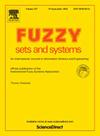On the centroid of a general type-2 fuzzy set with monotonically increasing second membership functions
IF 3.2
1区 数学
Q2 COMPUTER SCIENCE, THEORY & METHODS
引用次数: 0
Abstract
In a type-2 fuzzy logic system, the centroid computation of a general type-2 fuzzy set (T2 FS) is one of the most important type reduction methods. Nearly all of the existing algorithms are based on the α-plane representation or z-slice representation. Therefore, all of these algorithms can only approximately compute the centroid of a general T2 FS and cannot obtain the analytic expression of the centroid of a general T2 FS. The main objective of this study is to obtain the analytic expression of the centroid of a general T2 FS with monotonically increasing second membership functions based on a discrete universe of discourse. First, assuming that the second membership functions of a general T2 FS is linear and monotonically increasing, a method is proposed to compute its centroid. Second, an approach to calculate the centroid of a general T2 FS is also analyzed, if the second membership functions are only monotonically increasing. Finally, two numerical examples are given to demonstrate the calculation processes of the proposed method in this study. Notably, the proposed method can also be employed to obtain the analytic expression of the centroid of a general T2 FS with monotonically decreasing second membership functions.
关于具有单调递增第二成员函数的一般第二类模糊集的中心点
本文章由计算机程序翻译,如有差异,请以英文原文为准。
求助全文
约1分钟内获得全文
求助全文
来源期刊

Fuzzy Sets and Systems
数学-计算机:理论方法
CiteScore
6.50
自引率
17.90%
发文量
321
审稿时长
6.1 months
期刊介绍:
Since its launching in 1978, the journal Fuzzy Sets and Systems has been devoted to the international advancement of the theory and application of fuzzy sets and systems. The theory of fuzzy sets now encompasses a well organized corpus of basic notions including (and not restricted to) aggregation operations, a generalized theory of relations, specific measures of information content, a calculus of fuzzy numbers. Fuzzy sets are also the cornerstone of a non-additive uncertainty theory, namely possibility theory, and of a versatile tool for both linguistic and numerical modeling: fuzzy rule-based systems. Numerous works now combine fuzzy concepts with other scientific disciplines as well as modern technologies.
In mathematics fuzzy sets have triggered new research topics in connection with category theory, topology, algebra, analysis. Fuzzy sets are also part of a recent trend in the study of generalized measures and integrals, and are combined with statistical methods. Furthermore, fuzzy sets have strong logical underpinnings in the tradition of many-valued logics.
 求助内容:
求助内容: 应助结果提醒方式:
应助结果提醒方式:


